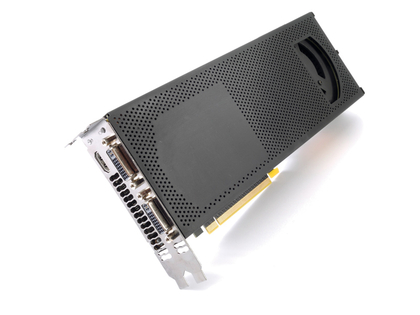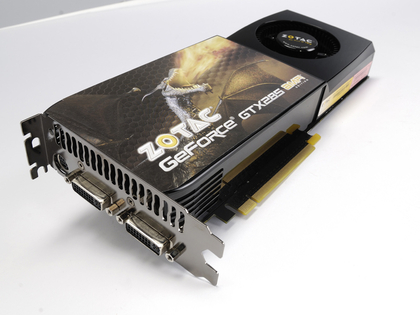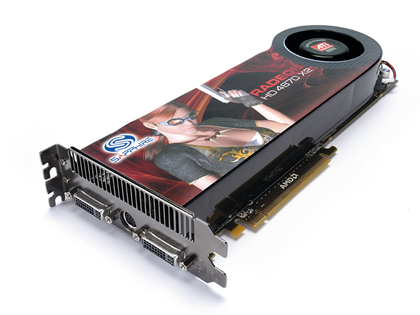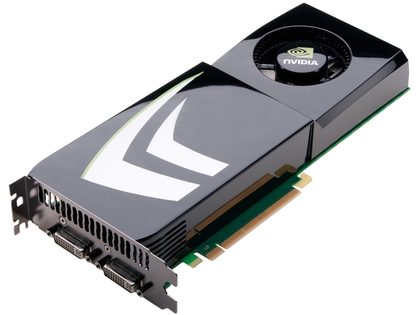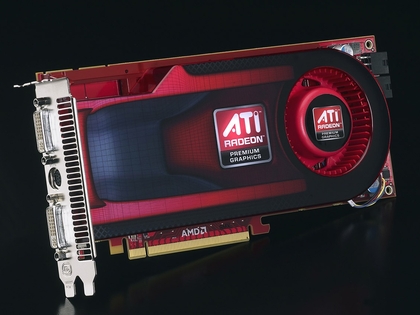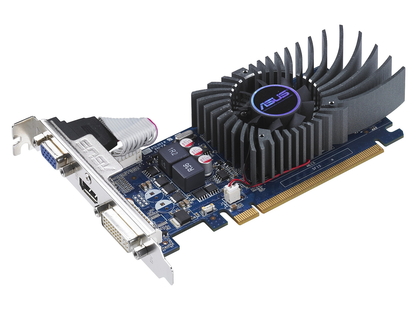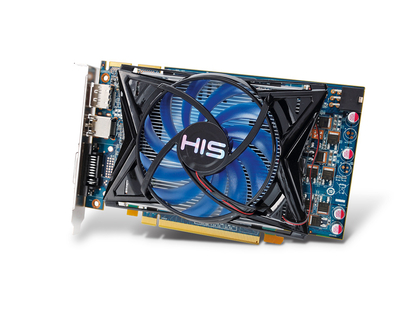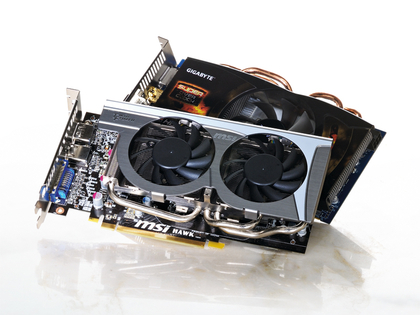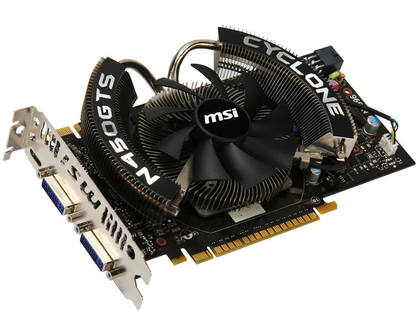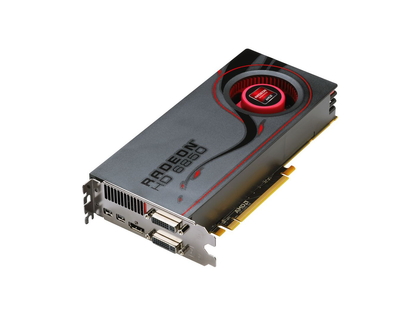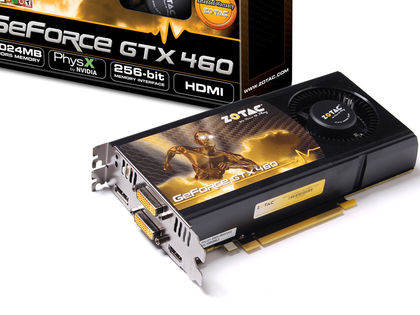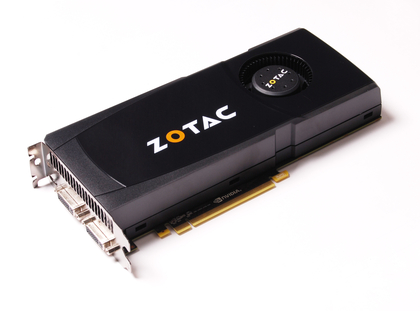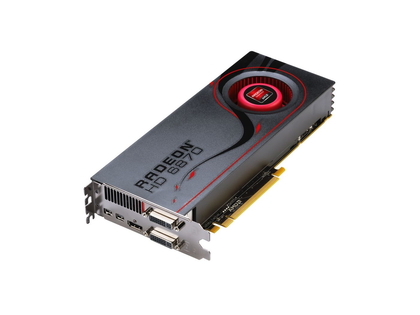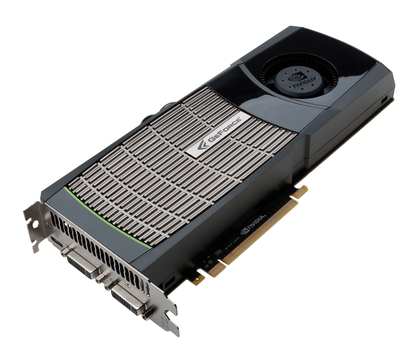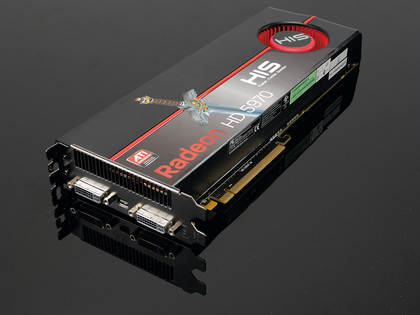5. Nvidia GeForce GTX 460 1GB
- Price: £140
- GPU: GF104
- Manufacturing process: 40nm
- Memory: 1,024MB GDDR5
The 1GB version of the GTX 460 (there’s also a noticeably less powerful 768MB iteration) started at a price-point which undercut its immediate Radeon-shaped competition by a fair margin, and that’s only got better as the months have gone by.
The GTX 460′s rejigged GF100 GPU though may sound like Nvidia has just chopped the GTX 480′s chip in half, with only seven streaming multiprocessors (SMs) against the older card’s fourteen, but inside, things have most definitely changed.
These SMs are the units that hold the myriad CUDA cores (previously known as shader processors), special function units (SFUs), texture mapping units (TMUs) and the polymorph engines that contain the all-important tessellation grunt.
The SMs of the GF100 chips contain a maximum of 32 shader cores, four SFUs and four TMUs. In the GTX 460 chip though NVIDIA has squeezed another 16 CUDA cores into each SM and upped the SFU and TMU counts to eight per SM.
Each of these SMs has also had some CPU-like extra multi-threading goodness injected into them in the shape of an extra couple of dispatch units in each of them.
What this means is awesome midrange performance, and respectable performance at resolutions higher than 1680×1050. Pair a couple up for SLI kicks though, and you get a punchy setup that kicks Nvidia’s own GTX 280 into touch.
4. Nvidia GeForce GTX 470
- Price: £200
- GPU: GF102
- Manufacturing process: 40nm
- Memory: 1,280MB GDDR5
Not so hot on the heels of Nvidia’s first DX11 graphics cards came the GeForce GTX 470, a cut-down version of the GF100 GPU the green company is rightfully proud of.
Given the larger pricetag of its big brother, the GTX 480, this represents the most affordable high-end Fermi card out there.
Like the rest of the Fermi range, the 470 has seen some nifty price-cuts, which means it can now be had for £200 (we’ve seen it as low as £188 online). This makes the cheapest 470s at just £30 more expensive than the GTX 460 1GB, the new midrange king. That makes it a pretty compelling prospect right now.
In addition, at the native 22-inch resolution of 1,680×1,050, this card is a fair way ahead of the HD 5870. When things get cranked up though, it starts to lose its competitive edge against AMD’s upper-midrange peer.
Indeed, in our World in Conflict benchmark it actually dropped behind. Still, thanks to its Fermi roots, the GTX 470 has still got the tessellation goods and this promises some future-proofing.
Thankfully, production has ramped up nicely, and the early stock-issues that plagued the 470 and 480 are now long past. More cards in stockrooms means lower prices everywhere, so keep an eye on the 470 – it may yet drop some more.
3. AMD Radeon HD 6870
- Price: £200
- GPU: BARTS XT
- Manufacturing process: 40nm
- Memory: 1,280MB GDDR5
AMD’s 6870 is really the march of things to come for AMD. The BARTS GPU will drive AMD’s high-end 6000 series, which hits later this month, and that makes the 6870 something of a stop-gap measure between the this and the 5000 series of cards.
As the advance-guard of AMD’s 6000-series, It also brings some new functionality to the party, in the name of HD3D. This is AMD’s passive 3D technology – largely nascent at present – but the card also supports HDMI 1.4a for 3D Blu-Ray displays.
Architecturally, this mainstream card is a cross between the 5830 and 5850. You get the full-fat 32 ROPs as found on the 5850, but with a core configuration of 1,120 stream processor, as found inside the 5830.
The tweaked core operates at a far higher clock rate to either of these predecessors though, cranking along at 900MHz, as opposed to the 750MHz of the 5850 and the 5830′s 800MHz.
In real terms this means that the 6870 is faster than the 5850, but it’s a little slower than the 5870, so don’t assume because it’s one number higher on the title, there’s a huge generation gap. It’s also faster than its closest competition on the Nvidia front, the GTX 460, and impressively, the GTX 470 as well.
For £200, there’s a lot of value here, the HD 6870 brings AMD’s trademark elegance (reduced heat and noise output) to your PC. We’re eagerly awaiting the rest of the 6000 range to see what AMD has up its sleeve this generation.
2. Nvidia GeForce GTX 480
- Price: £320
- GPU: GF100
- Manufacturing process: 40nm
- Memory: 1,536MB GDDR5
You’d think graphics cards would get worse with age, but after numerous price-cuts, the late-to-the-DX11-party GTX 480 is still one of the strngest contenders due to the fact that it’s 24% cheaper than at its launch. Oh, and did we mention it’s also the fastest single GPU in existence? Frames-per-penny, the 5970 may be a better value proposition, but for those without £400 to throw around, the 480′s the next best thing.
The full Graphics Fermi 100 GPU (GF100) is a marvel of graphical architecture, but some of the 512 small processing (CUDA) cores had to be dropped. The GTX 480 then comes with 480 of these cores, but still manages to pack one hell of a punch.
The key for Fermi, and the purported reason for its lengthy delay, was to ensure it had the best possible tessellation performance.
Tessellation is going to be one of the key tasks for future GPUs, the ability to render more detailed geometry rather than simply better, smoother textures, and Nvidia wants to be at the forefront.
The difficulty is that once tessellation becomes that important, and heavily used in modern gaming development, this card may not quite have the grunt. For now though it’s still an incredible piece of engineering.
The minimum aim for the GTX 480 was to beat AMD’s HD 5870 and, it manages that, making it the fastest single-GPU card around. Let’s see if that changes with AMD and Nvidia’s imminent range-refreshes.
1. ATI Radeon HD 5970
- Price: £425
- GPU: Hemlock XT (2 x RV870)
- Manufacturing process: 40nm
- Memory: 2 x 1,024MB GDDR5
So here it is; the fastest commercial graphics card available today; the Radeon HD 5970.
AMD has taken the top spot and managed to hold out against the latest Fermi card from Nvidia, the GeForce GTX 480.
This twin-GPU beauty is one big, beefy, powerhouse of a graphics card, capable of spewing out polygons like last night’s bad kebab. And it since its launch, we’ve seen over £100 fall from the price-tag to keep the stock flowing.
It isn’t just two HD 5870s strapped onto one slab of PCB though – there’s definitely nothing simple about fitting two graphics cards into one form factor.
The actual GPUs are slightly slower than a vanilla HD 5870, making them more akin to twin overclocked HD 5850s. This also means that a Crossfire setup sporting two actual HD 5870s will beat this card in a foot race. But this is Crossfire made easy and that’s something that could rarely be said in the past.
Surprisingly, given the power requirements, it doesn’t get quite as hot as the volcanic GTX 480, a card that actually wiped some of our fingerprints during testing. And surprisingly, it’s remarkably stable and happy to be overclocked.
Some would say that overclocking what is already the fastest graphics card in the world is a bit like overkill, but the option is there for the brave. There are concerns over driver support though, given that DX11 launch title, and AMD Game titleDiRT 2 didn’t support the multi-GPU HD 5970 until very recently, so like Crossfire in general, it could present compatibility questions going forward.
It’s not as dear as it was, but it’s still pricey, and what that means with both Nvidia and AMD refreshes on the horizon is anyone’s guess. Ours would be: further price cuts. Affordability FTW!
And right now, it’s still the fastest graphics card out there, posting figures with a healthy lead over the closest competitor from Nvidia. Considering that just a couple of generations ago ATI looked to be choking on Nvidia’s dust with the HD 3xxx series of cards, it’s quite incredible that it has managed to take the top spot and hold it against cards coming out almost half a year later.
Hats off to you then HD 5970, you are the fastest graphics card in the world.
 Nerve centre: Super-servers which act for storage for many companies are also used by WikiLeaks to store its information
Nerve centre: Super-servers which act for storage for many companies are also used by WikiLeaks to store its information U-boat back-up: Submarine engines are used as emergency generators at the Bahnhof internet service provider, in Stockholm, Sweden
U-boat back-up: Submarine engines are used as emergency generators at the Bahnhof internet service provider, in Stockholm, Sweden Chilly reception: The bunker, drilled into granite under the Vita Berg Park, could withstand a nuclear attack
Chilly reception: The bunker, drilled into granite under the Vita Berg Park, could withstand a nuclear attack








